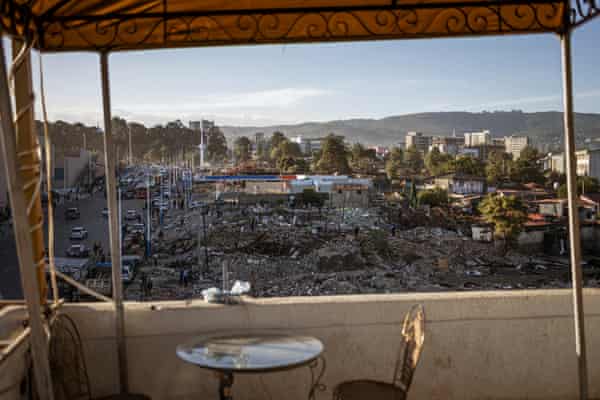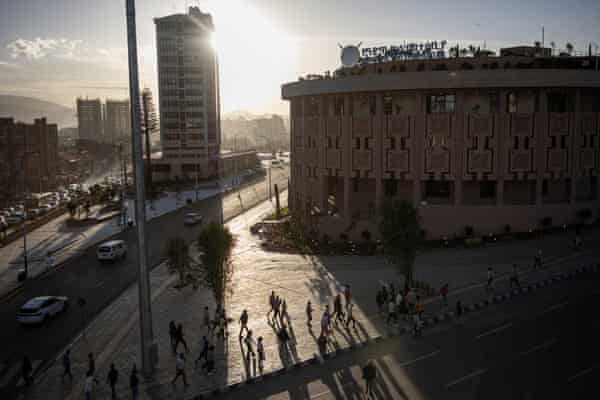Ethiopia : The demolition of a historic district in the capital Addis Ababa, with people’s homes and livelihoods destroyed
In the heart of Addis Ababa, the historic, ramshackle neighbourhood of Piassa once teemed with shops and cafes. People would come from across Ethiopia’s capital city to buy anything from jeans to jewellery.
Today it lies in ruins. Its distinctive stone houses, with their wooden balconies and slanting metal roofs, are almost all gone. In their place are jagged fields of rubble, picked over by workers with sledgehammers.
People stop to stare at the wreckage. Some take pictures. But they do not stay long: the ruins are guarded by police carrying clubs. “I’m angry,” says a former resident. “It’s my heritage that’s been destroyed in front of my eyes, without any consultation at all. We were never told the plan.”

For years there had been vague talk of demolishing Piassa, sweeping away the densely packed shantytowns that had sprung up between its historic buildings. The area has witnessed small-scale demolitions. But when the bulldozers moved in last month, it was unexpected. One person says they were given five days’ notice that their family home of more than 50 years would be knocked down. The water and power were cut off after three days.
“Many of our belongings were damaged or stolen during the chaotic process of vacating,” they say.
Like everyone in Addis Ababa the Guardian spoke to, they talked on the condition of anonymity, citing fear of reprisals. Several former residents and heritage experts declined to be interviewed at all.
A new building stands at the heart of Piassa: the recently inaugurated Adwa Victory Memorial Museum. A low-slung complex of orange stone, constructed to commemorate Ethiopia’s historic defeat of Italian colonialists in 1896, it is the latest large-scale project built by Abiy Ahmed, the prime minister since 2018.

His other projects include a national library, a science museum and a host of manicured parks. Abiy’s administration has also renovated Meskel Square, Ethiopia’s most important public space. The biggest venture is a palace complex on a hill above the city, reported to cost $10bn (£8bn). The financing of the grand palace is opaque, though most western diplomats in the city suspect it is being bankrolled by the United Arab Emirates, which has been expanding its influence in the Horn of Africa. When questioned by MPs last year, Abiy said it did not concern them because it was not part of the official budget.
“This is a leader who uses built space as a political tool,” says an architect. “Every time people ask about these projects, they are just shut down.”
Piassa was torn down as part of a “road-widening project”. Other demolitions are also taking place. A tailor in a neighbouring district to Piassa said they were given one hour to clear their shop, with no explanation. They later discovered it is due to be replaced by a cycle path.
Piassa was built by Emperor Menelik II, the father of modern Ethiopia, soon after he founded Addis Ababa in the 1880s. It was developed by the Italians, who gave it its current name – it is sometimes called Piazza – during their occupation of Ethiopia in the 1930s. People in the capital considered it their Old Town, but it was also a hub of modernity throughout the 20th century, the place where new technologies first arrived in the country.

“It was the seat of modern Ethiopian history,” says a heritage expert. “They wouldn’t have wiped out their own heritage if they understood this.” Marco Di Nunzio, an anthropologist at the University of Birmingham who studied Addis Ababa’s inner city for several years, says: “There’s no doubt the area needed renovation. But the question is how to do that. The demolitions have not only destroyed old buildings that needed upgrading. They have disrupted livelihoods, displaced residents and damaged part of the soul of the city.”
Like the people cleared from other city neighbourhoods, those uprooted from Piassa have been relocated to new housing. This is often on the outskirts of the city, far from their schools and workplaces. Much of it is unfinished. A video shared by one person removed from Piassa of their new apartment shows a concrete husk, with no plaster on the walls, and no flooring, glazing or plumbing. “There were people who were more unfortunate than us, who were told they would be living in blocks of apartments which don’t exist,” she says.
Experts say Piassa’s destruction broke Ethiopia’s heritage law and urban planning regulations, though the government denies this. Thirty-six of the neighbourhood’s 42 listed buildings have either been destroyed or earmarked for demolition, say heritage experts. Abiy believes it is necessary to remove poverty from Addis’s centre to attract foreign investment and tourism. Earlier this month, he suggested Dubai as a model.
“While some individuals may be disappointed that their fences are being demolished, the country will not change unless we take bold measures,” Abiy said. “In a year’s time, we will witness a transformed Addis Ababa. Tourists will start to come, increasing the value of your property.”

Yet some in the city are questioning if these projects are the best use of public funds. Ethiopia is struggling with soaring inflation and a foreign currency crunch. It is also facing a reconstruction bill of nearly $23bn from a two-year civil war in Tigray, which ended in 2022. Millions of Ethiopians rely on food aid, but the humanitarian response plan to help them was only 34% funded last year.
The city is now coming to terms with its loss. “You don’t have to choose between heritage and development,” says a resident. “Piassa should have been protected and conserved, and this could have easily been done.”
